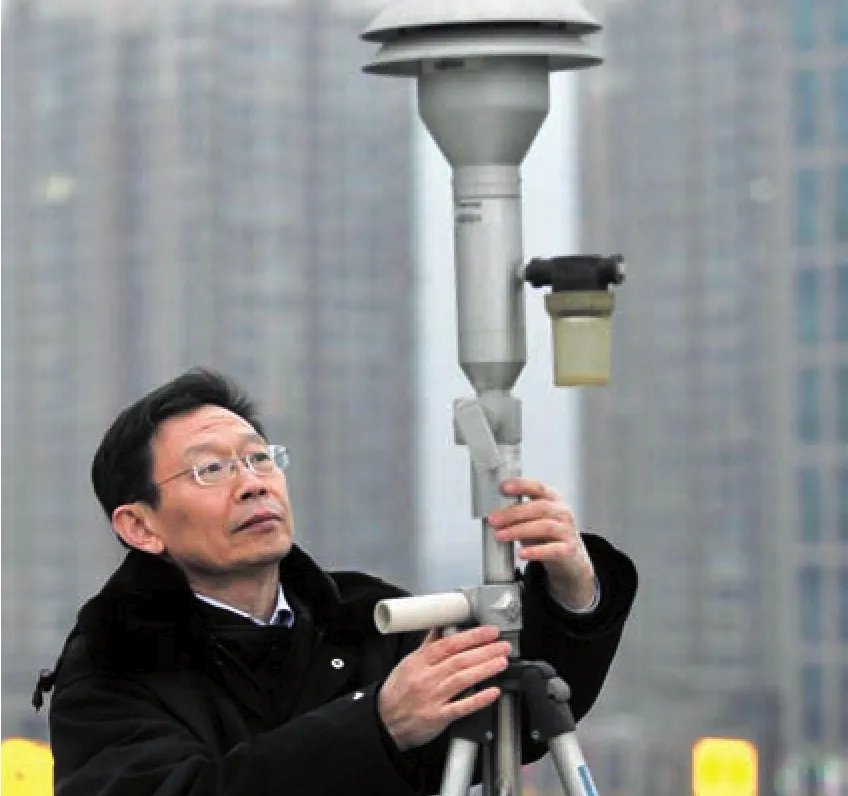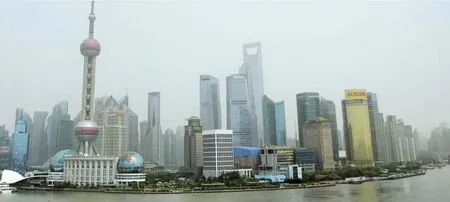Breathe Easier
2012-10-14BeijingtakestheleadtoestablishhigherstandardsinstrivingforcleanerairByYinPumin
Beijing takes the lead to establish higher standards in striving for cleaner air By Yin Pumin
Breathe Easier
Beijing takes the lead to establish higher standards in striving for cleaner air By Yin Pumin
Starting on February 2, a new figure showing the 24-hour average concentrations of PM2.5, an important gauge of air quality, appeared on the website of the Beijing Municipal Environmental Protection Bureau (EPB).
Earlier, the bureau started to publish hourly readings of PM2.5 on January 21.
PM2.5 refers to fi ne particles 2.5 microns or less in diameter, which are believed to pose greater health risks than larger particles because they can penetrate people’s lungs or even enter the blood stream.
“The hourly data reveals the instant increase in PM2.5 density, but fails to indicate the overall air quality of the day,” said Zhao Yue, Deputy Director of the Beijing Environmental Monitoring Center (BEMC).
By comparison, the 24-hour average data is a standard adopted by many developed countries. “It precisely shows the overall air quality and makes it much easier for the public to judge whether the air is harmful to their health or not,” Zhao said.
Besides the new daily average, BEMC is also ready to release hourly measurements of three other types of airborne matter—sulfur dioxide, nitrogen dioxide and inhalable particles.
Public promotion
Beijing residents have long been dissatisfied with the official air quality figures,saying they fail to reflect the real level of danger to inhabitants. They called on the government to adopt the tighter PM2.5 standard, instead of the previous PM10, or fine particles under 10 microns in size, to measure air quality.
Wang Yuesi, a researcher at the Institute of Atmospheric Physics of the Chinese Academy of Sciences, has been monitoring data of both PM2.5 and PM10 since 1998. His studies found that the average density of PM10 in Beijing is decreasing at a rate of 2-3 percent every year,but PM2.5 concentrations are increasing by 3-4 percent on an annual basis.
Wang said that the growing number of motor vehicles and increasing industrial pollution contribute to a higher concentration of smaller particles.
According to official data, the average annual PM2.5 density in Beijing was 70-80 micrograms per cubic meter in 2010,more than double the target of 35 micrograms a cubic meter set by the Ministry of Environmental Protection (MEP).
Scientists estimate that 50 percent of the total PM2.5 particles in the air are contributed by automobile exhaust, and another 23 percent are brought by fl oating dust.
Beijing is not the only city facing a public outcry over pollution. Many Chinese cities are periodically enveloped in heavy smog, deepening public frustration over the quality of the air people breathe every day.
According to the Shanghai Environmental Monitoring Center, the average annual density of PM2.5 in the city was 44-53 micrograms a cubic meter in 2006-10.
“A pilot monitoring program for PM2.5 in nine cities, including Shanghai, Tianjin and Guangzhou, since 2007 shows that particulate pollution is a common challenge,”said Luo Yi, Director of the China National Environmental Monitoring Center.
“Including PM2.5 readings is an essential part of tackling the country’s haze problems, and it reflects the growing influence of public concern on air quality monitoring,” said Ma Jun, Director of the Beijing- based Institute of Public and Environmental Affairs.
On December 21, 2011, after more than one month of public hearings, the MEP laid out a detailed timetable for Chinese cities to monitor PM2.5.
According to the timetable, cities in the Beijing-Tianjin-Hebei region, the Yangtze River Delta and the Pearl River Delta, as well as southwest China’s Chongqing Municipality and provincial capitals, should start monitoring PM2.5 and ozone in 2012.

GONG LEI
The new air quality standards will apply to the whole country by January 1, 2016, and the monitoring results will be made public.
No easy task
Although tighter monitoring standards will soon be introduced nationwide, it will not be easy for Beijing and other cities to meet accepted PM2.5 standards and then further control pollution.
Technically, it is not difficult to monitor PM2.5 as it is similar to monitoring PM10, said Zhu Jianping, Deputy Director of the MEP’s Department of Environmental Monitoring.
However, the biggest problem is financing. PM2.5 monitoring equipment usually costs 80,000-380,000 yuan ($12,710-60,370). A preliminary estimate shows that more than 338 prefecture-level cities will have to invest more than 2 billion yuan ($318 million) on the new equipment, Zhu said.
“Following the introduction of the new gauge, the number of reported good weather days will likely decrease. However, the figures will not be shameful as long as a real effort is being made to improve the situation,”said Xu Ming, Vice Governor of east China’s Jiangsu Province.
“Reducing air pollution in China during its current development phase is a massive systematic project,” said Hao Jiming, Director of the Institute of Environmental Sciences and Engineering at Tsinghua University. He predicted that it would take at least 10 years for Beijing to meet the national standards currently established under the PM2.5 gauge.
Wu Dui, a researcher at the Tropical Oceanic Climate Institute of the China Meteorological Administration, suggested that local governments need stronger incentives to aggressively tackle air pollution. “The performance criteria for local governments should be broadened to include hard environmental targets, not just GDP,” he said.
In the vanguard
Currently, there is only one PM2.5 monitoring station in Beijing, but the EPB plans to build a citywide network of more than 30 stations by the end of this year, as this will allow it to release real-time PM2.5 data.
“The monitoring stations will turn into nothing but a decoration if they cannot objectively re fl ect air pollution and contamination,”said Wang Qiuxia, a researcher at Green Beagle, a non-governmental environmental organization in Beijing.
The EPB said the capital would locate the stations in accordance with general international practices. “The stations will be located selectively, neither around the cleanest nor most polluted areas,” Yu said.
According to existing national standards,a monitoring location should be 50 meters away from a pollution source, including automobile exhaust.
Meanwhile, the Beijing Municipal Government has also laid down a series of measures that will tighten controls on air pollution in the city.

(Left) CHECKING THE AIR: A worker at the Beijing Environmental Monitoring Center adjusts the monitoring equipment for the PM2.5 measure of air quality in Beijing on January 7 A GREY SKY: Smog covers the Lujiazui Finance and Trade Zone in Shanghai on May 3,2011
According to a public spending budget released by the Beijing Municipal Finance Bureau in January, the municipal government will allocate 2.1 billion yuan ($334 million)to tackle air pollution and cover other work related to energy conservation and emissions reduction.
“Starting in March, the city will begin planting trees on 13,333 hectares of land between its fi fth and sixth ring roads,” said Vice Mayor Chen Gang at the annual session of the Beijing Municipal People’s Congress, the local legislature, in January.
A number of currently desolate areas will be used for the forestation project, which by 2014 is expected to cover 66,667 hectares.
Besides the ambitious forestation plan,Beijing will also introduce more stringent emission standards, improve fuel oil quality,strengthen the control of dust in construction sites and further cooperate with neighboring cities.
This year, 150,000 old cars that cause heavy air pollution will be recycled and coal- fi red boilers will be replaced with clean energy heating.
On January 4, Beijing introduced draft regulations on new standards for gasoline and diesel in the city. The move is intended to improve fuel quality, especially by reducing the sulfur content in gasoline.
“Reducing the sulfur content in gasoline means less sulfur dioxide in vehicle exhaust emissions, which is responsible for acid rain as well as a major contributor to PM2.5,” said Zhang Yuanxun, a professor at the Chinese Academy of Sciences.
Furthermore, a primary target has been set to introduce Euro V emission standards for exhaust emissions of new vehicles to replace the current Euro IV standards by the end of this year, pressuring automakers to upgrade their products to reduce emissions
“There are 5 million motor vehicles in Beijing,” said Yu Jianhua, Director of the EPB’s Air Pollution Control Division. “In congested cities, the incomplete combustion of fuel leads to a tremendous increase in the density of PM2.5.”
Du Shaozhong, Deputy Director of the EPB, said that cooperation between Beijing and neighboring cities is significant to tackling the city’s environmental problems.
“We should collaborate with neighboring cities, such as Tianjin and Langfang in Hebei Province, to solve the problem,” Du said.
